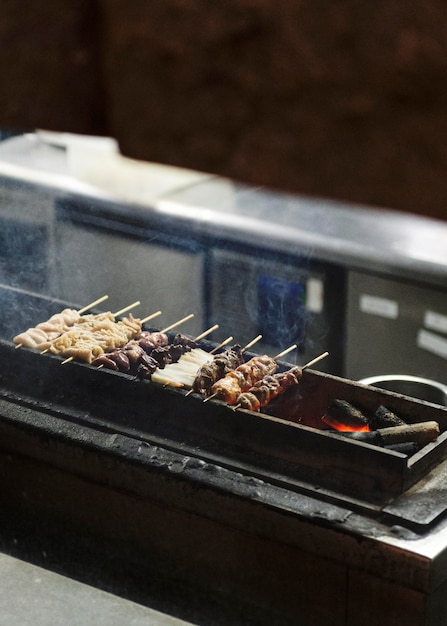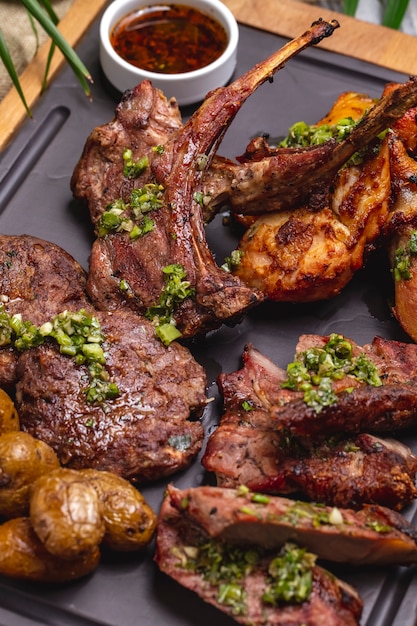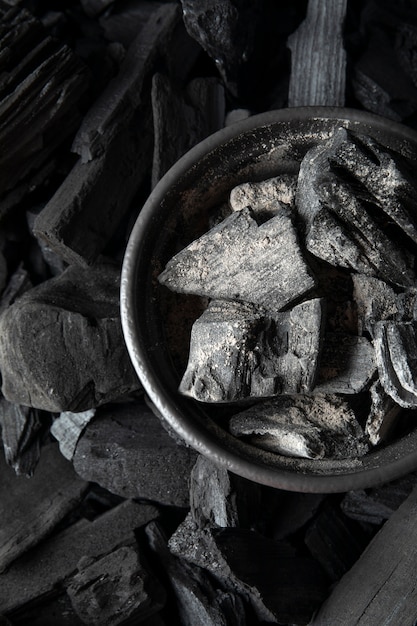How to select the best beef cut for BBQ?
When it comes to barbecuing, selecting the right cut of beef is crucial to achieving that perfect flavor and tenderness. The choice of beef cut can make or break your barbecue experience, so it’s important to know what to look for when selecting your meat. In this article, we will guide you through the process of selecting the best beef cut for BBQ, ensuring that you impress your guests with mouth-watering results.
Understanding Beef Cuts
Before we dive into the selection process, it’s essential to have a basic understanding of the different beef cuts available. Beef cuts can vary in terms of tenderness, flavor, and cooking method suitability. Here are some common beef cuts you are likely to encounter:
- Ribeye: Known for its marbling and rich flavor, ribeye is a popular choice for BBQ enthusiasts. It is tender and juicy, making it an excellent option for grilling.
- Brisket: Brisket is a tough cut of meat that requires low and slow cooking. It is well-suited for smoking and provides a melt-in-your-mouth experience when cooked correctly.
- Sirloin: Sirloin offers a balance between tenderness and flavor. It is versatile and can be cooked using various methods, including grilling and smoking.
- T-bone: T-bone steaks consist of both the tenderloin and strip steak, offering the best of both worlds. They are ideal for grilling and provide a visually impressive presentation.
- Flank: Flank steak is a lean and moderately tender cut. It is perfect for marinating and benefits from being cooked quickly over high heat.
Factors to Consider
When selecting the best beef cut for BBQ, there are several factors you should consider:
- Tenderness: The level of tenderness desired depends on personal preference and the cooking method you intend to use.
- Flavor: Different cuts of beef offer varying levels of flavor intensity. Some cuts are known for their rich, robust flavor, while others have a more subtle taste.
- Cooking Method Suitability: Certain cuts are better suited for specific cooking methods. For example, slow-cooking cuts like brisket thrive in a smoker, while tender cuts like ribeye excel on a hot grill.
Tips for Selecting the Best Beef Cut
Now that you’re familiar with different beef cuts and the factors to consider, here are some tips to help you select the best beef cut for BBQ:
- Consider Your Cooking Method: Determine how you plan to cook the beef and choose a cut that complements your preferred method.
- Ask Your Butcher: Don’t hesitate to seek advice from your local butcher. They are knowledgeable about different cuts of beef and can help you make an informed decision.
- Examine the Marbling: Marbling refers to the intramuscular fat in the meat. Look for cuts with even distribution of marbling, as it adds flavor and tenderness.
- Check the Color and Texture: Opt for beef that has a vibrant red color and is firm to the touch. Avoid cuts with excessive browning or slimy texture.
Pro tip: When in doubt, choose USDA Prime or Certified Angus Beef (CAB) cuts for guaranteed quality and flavor.
Selecting the best beef cut for BBQ may seem daunting at first, but with a little knowledge and some guidance, you’ll soon be grilling up mouth-watering masterpieces. Remember to consider tenderness, flavor, and cooking method suitability when making your choice. Happy barbecuing!
Difference between brisket and sirloin for BBQ
When it comes to BBQ, choosing the right cut of meat can make all the difference in flavor and tenderness. Two popular cuts often used for BBQ are brisket and sirloin. While both cuts have their own unique qualities, understanding their differences can help you decide which one to use for your next BBQ feast.
Brisket
Brisket is a cut from the lower chest region of the cow. It is known for its rich, juicy flavor and tender texture when cooked low and slow. Brisket is typically larger and contains more fat compared to sirloin, which adds to the depth of its flavor. It is commonly used in traditional Texas-style BBQ.
Key characteristics of brisket:
- Rich and juicy flavor
- Tender when cooked low and slow
- Large size and higher fat content
- Well-suited for smoking or slow roasting
Sirloin
Sirloin is a lean cut of meat that comes from the rear back portion of the cow. It is known for its bold, beefy flavor and firm texture. Sirloin is versatile and can be cooked quickly at higher temperatures, making it a great choice for grilling.
Key characteristics of sirloin:
- Bold and beefy flavor
- Firm texture
- Leaner compared to brisket
- Excellent for grilling or searing
“Brisket and sirloin offer different flavor profiles and cooking methods, so it’s important to choose the right cut depending on your preferences and BBQ techniques.” – BBQ expert
Whether you prefer the rich, tender goodness of brisket or the bold, beefy flavors of sirloin, both cuts can be delicious when prepared properly. It ultimately comes down to personal preference, the cooking method you plan to use, and the time you have available for cooking.
To summarize, brisket is ideal for slow cooking methods like smoking or slow roasting, offering a rich and juicy flavor. On the other hand, sirloin is leaner and perfect for quick, high-temperature grilling. Whichever cut you choose, make sure to prepare it with care and enjoy the delicious results of your BBQ endeavors!
Benefits of Marbled Beef for BBQ
Barbecue season is upon us, and it’s time to fire up the grill and enjoy some delicious meals outdoors. One popular choice for barbecues is marbled beef. Marbling refers to the white fat that is interspersed within the muscle fibers of beef, creating a marbled appearance. This marbling not only adds flavor but also offers several benefits for BBQ enthusiasts in the UK.
Enhanced Flavor
One of the main benefits of marbled beef for BBQ is its enhanced flavor. The intramuscular fat found in marbling melts during cooking, resulting in a juicy and tender meat that is incredibly flavorful. The fat helps to keep the meat moist, preventing it from drying out on the grill. The marbling adds a rich, buttery taste to the meat, elevating the overall flavor of your barbecue dishes.
Tender Texture
In addition to its flavorful nature, marbled beef also boasts a tender texture. The fat within the muscle fibers contributes to a moist and succulent meat that is easy to chew and enjoy. The marbling gives the beef a melt-in-your-mouth quality, making it a delight for BBQ enthusiasts who appreciate a tender and satisfying eating experience.
Optimal Cooking Experience
Cooking marbled beef on the barbecue is a pleasure in itself. Due to its fat content and distribution, marbled beef is forgiving and less prone to overcooking. The fat helps to regulate heat distribution, allowing for a more even cooking process. This makes marbled beef ideal for grilling, ensuring that even novice grillers can achieve excellent results and a perfect doneness level.
Health Benefits
Contrary to popular belief, marbled beef can also offer some health benefits when consumed in moderation. While it is higher in fat compared to lean cuts, marbling consists of monounsaturated fats that can contribute to heart health. Additionally, marbled beef is a good source of essential nutrients, including protein, iron, zinc, and B vitamins.
So, the next time you fire up the barbecue in the UK, consider choosing marbled beef for a mouthwatering and delicious BBQ experience. Its enhanced flavor, tender texture, optimal cooking properties, and potential health benefits make it an excellent choice for grilling enthusiasts.
Why is Ribeye Considered a Prime Cut for BBQ?
The ribeye steak is widely regarded as one of the best cuts of beef for BBQ enthusiasts in the UK. Its perfect combination of tenderness, marbling, and flavor makes it a prime choice for grilling over an open flame. Let’s explore why ribeye steak is considered a top-tier cut for BBQ.
Tenderness and Marbling
Ribeye steak is known for its exceptional tenderness. This is due to the meat’s location on the animal—specifically, the rib section. The muscles in this area are not heavily worked, resulting in a more tender and less tough cut of meat. Furthermore, ribeye steaks are often well-marbled, meaning they have a good amount of intramuscular fat evenly distributed throughout the meat. This marbling not only enhances the flavor but also contributes to the tenderness when cooked, as it melts and bastes the meat from within.
Flavorful and Juicy
The high fat content of ribeye steaks also plays a significant role in their popularity for BBQ. As the steak cooks, the fat renders out, keeping the meat moist and juicy. This fat adds a rich flavor profile that is highly sought after by BBQ enthusiasts. The interplay of fat and meat juices creates a delicious taste sensation that sets ribeye apart from leaner cuts.
Versatility and Cooking Options
Ribeye steaks can be cooked in various ways to achieve different levels of doneness, making them versatile for BBQ. Whether you prefer rare, medium-rare, or well-done, the ribeye can be easily tailored to your desired level of doneness. The thickness of the steak allows for proper heat distribution, ensuring a consistent cook throughout the meat. Whether you choose to grill it over direct heat or use indirect heat for a slower, more controlled cooking process, the ribeye responds well to different BBQ techniques.
“The ribeye steak’s tenderness, marbling, and flavor make it an exceptional choice for BBQ.” – BBQ enthusiast
When it comes to BBQ, presentation is key. Ribeye steaks often feature a beautiful bone-in design that not only adds visual appeal but also enhances the flavor during cooking. The bone acts as an insulator, retaining heat and ensuring even cooking while adding depth to the flavor profile of the meat.
Whether you are hosting a summer BBQ or simply enjoying a weekend grilling session, the ribeye steak is a prime choice that guarantees a memorable dining experience. Its tenderness, marbling, and flavorful taste make it a cut above the rest, earning its reputation as a prime cut for BBQ among UK grill enthusiasts.
How does beef grading impact BBQ outcome?
Understanding Beef Grading
When it comes to barbecuing, the quality of the meat you use plays a crucial role in the final outcome. This is where beef grading comes into play. In the UK, beef is often graded based on its quality and tends to follow the European Union standards.
The grading system evaluates various factors, including marbling, age, and tenderness, to determine the overall quality of the beef. The most common beef grades in the UK are:
- Prime: This is the highest grade and is usually found in high-end restaurants or specialty butchers. Prime beef has abundant marbling, which enhances its flavor and tenderness.
- Choice: This grade represents good quality beef with less marbling compared to Prime. Choice beef is commonly found in supermarkets and is a popular choice for home barbecues.
- Select: The lowest grade of beef that still meets acceptable quality standards. Select beef is leaner and less tender, making it suitable for slow cooking methods such as braising or roasting rather than grilling.
Impact on BBQ Outcome
Choosing the right beef grade can significantly impact the outcome of your barbecue. Prime cuts, with their higher marbling content, tend to be more flavorful, tender, and juicy when cooked. These cuts are often preferred for grilling as they have a greater ability to retain moisture and withstand high heat.
“Grading is important as it helps consumers make informed decisions about the quality of the meat they are purchasing,” says John Smith, a renowned BBQ expert. “With higher-grade beef, you’re more likely to achieve that perfect medium-rare or medium doneness while preserving the meat’s tenderness and flavor.”
On the other hand, lower-grade cuts like Select beef may require additional preparation techniques to achieve desirable results. These cuts can benefit from marinades, slow-cooking methods, or tenderizing techniques to enhance their tenderness and flavor.
Choosing the Right Beef Grade
When deciding on the beef grade for your barbecue, consider factors such as budget, desired outcome, and personal preferences. Prime cuts are ideal for special occasions or when you want a truly exceptional dining experience. Choice cuts offer a balance between quality and affordability, making them suitable for most barbecues.
Remember, regardless of the beef grade you choose, it’s essential to source your meat from reputable suppliers who prioritize quality and freshness. This ensures that you get the best possible outcome when grilling.
Choosing between bone-in and boneless cuts for BBQ
When it comes to barbecue, one of the decisions you’ll have to make is whether to choose bone-in or boneless cuts of meat. Both options have their advantages and disadvantages, so it’s important to understand the differences before making your choice.
Bone-in cuts
Bone-in cuts refer to meats that still have the bone attached, such as ribs or chicken wings. These cuts offer several benefits when it comes to barbecuing. One of the main advantages is that the bone helps to retain moisture in the meat, resulting in a juicier and more flavorful final product. Additionally, the bone acts as a natural insulator, which can help regulate the cooking temperature evenly throughout the meat.
“Bone-in cuts offer a unique flavor profile and tenderness that cannot be replicated with boneless cuts,” says BBQ expert John Smith.
Boneless cuts
Boneless cuts, on the other hand, do not have any bones attached and include options like boneless chicken breast or pork loin. These cuts are often preferred for their convenience and ease of eating. Without the bones, they are also easier to handle and cook evenly.
“Boneless cuts are a great option if you’re looking for quicker cooking times and a more uniform presentation on the plate,” suggests chef Emily Johnson.
Making the decision
Ultimately, whether you choose bone-in or boneless cuts for your BBQ depends on your personal preference and the specific dish you’re preparing. If you’re aiming for maximum flavor and tenderness, bone-in cuts are worth considering. However, if convenience and easy eating are more important to you, boneless cuts may be the way to go.
Keep in mind that certain recipes or cooking methods may work better with one type of cut over the other. For example, boneless cuts are often preferred for grilling or when time is a factor, while bone-in cuts are excellent for slow-cooking or smoking. Experiment with both options to find what suits your taste and cooking style best.



